Introduction
Although 10–15% of couples are infertile [1], relatively few studies to date have probed the developmental genetics of human germ cell formation and differentiation in spite of the fact that poor germ cell production (poor quality and/or insufficient quantity) is a leading cause of infertility. Historically, the inaccessibility of germ cell development to studies in vivo and the lack of tools to study the pathways in vitro have limited progress in understanding human germ cell development. In recent years, however, with advances in human genetics, derivation of human embryonic stem cells (hESCs), reprogramming of somatic cells to induced pluripotent stem cells, and advances in clinical progress in in vitro fertilization, studies of human germ cell formation and differentiation are feasible and promise to enhance understanding of the unique pathways of germ cell development and their contribution to preimplantation, fetal, and postnatal development.
Rationale for studies of human germ cell formation and development per se
The examination of human germ cell development remains an important objective in spite of elegant studies in model systems that provide a foundation for understanding the divergence of the somatic and germ cell lineages early in human embryo development. Indeed, there are several unique aspects to human germ cell development that merit investment in these tools: firstly, genes and gene dosages required for human germ cell development differ from those of mice, including both autosomal and sex chromosomal genes and dosages [2–10]. Secondly and most importantly to human health, humans are rare among species in that infertility is remarkably common relative to other species, with nearly half of all infertility cases linked to faulty germ cell development [11]. Moreover, pathologies associated with meiotic errors are numerous in human development relative to other species. Indeed, meiotic chromosome segregation errors occur in as many as 5–20% of human germ cells depending on sex and age [12, 13]. This is in contrast to frequencies of approximately 1/10 000 cells in yeast, 1/1000 cells in flies, and 1/100 cells in mice. Finally, advances in pluripotent stem cell biology provide a unique opportunity to incorporate new strategies into our analysis of human germ cell development. This review addresses fundamental questions regarding human germline origins, function, and pathology and provides a foundation for considering rational therapeutics and diagnostics that inform clinical decisions.


